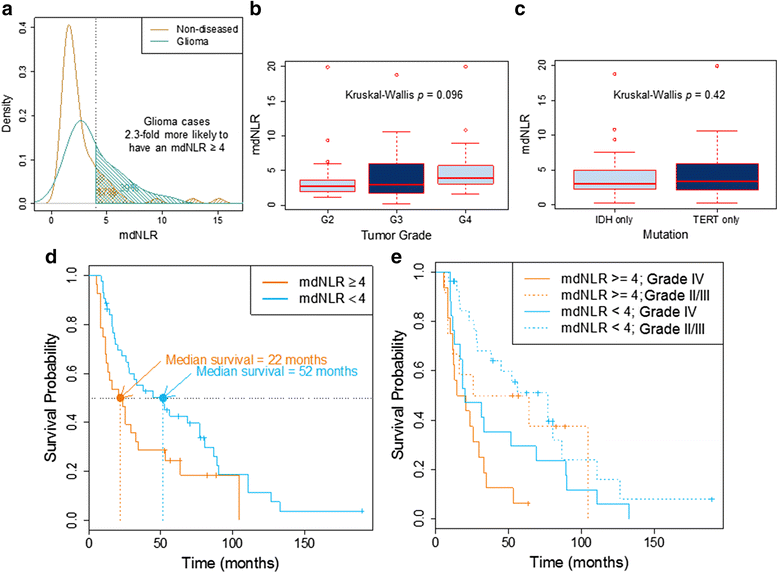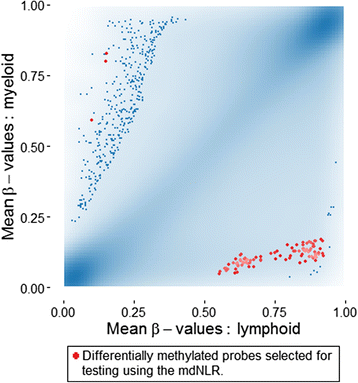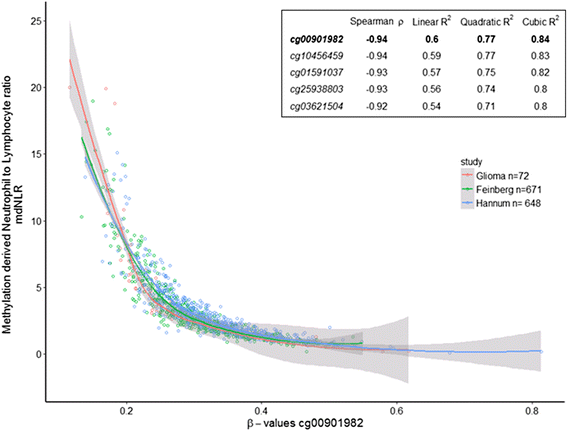Immunomethylomic approach to explore the blood neutrophil lymphocyte ratio (NLR) in glioma survival
- PMID: 28184256
- PMCID: PMC5288996
- DOI: 10.1186/s13148-017-0316-8
Immunomethylomic approach to explore the blood neutrophil lymphocyte ratio (NLR) in glioma survival
Abstract
Background: Differentially methylated regions (DMRs) within DNA isolated from whole blood can be used to estimate the proportions of circulating leukocyte subtypes. We use the term "immunomethylomics" to describe the application of these immune lineage DMRs to studying leukocyte profiles. Here, we applied this approach to peripheral blood DNA from 72 glioma patients with molecularly defined brain tumors, representing common patient groups with defined characteristic survival times and risk factors. We first estimated the proportions of leukocyte subtypes in samples using deconvolution algorithms with reference DMR libraries from isolated leukocyte populations and Illumina 450K DNA methylation data. Then, we calculated the neutrophil to lymphocyte ratio (NLR) using methylation-derived cell composition estimates (mdNLR). The NLR is considered an indicator of immunosuppressive cells in cancer patients.
Results: Elevated mdNLR scores were observed in glioma patients compared to mdNLR values of published controls. Significantly decreased survival times were associated with mdNLR ≥ 4.0 in Cox proportional hazards models adjusted for age, gender, tumor grade, and molecular subtype (HR 2.02, 95% CI, 1.11-3.69). We also identified five myeloid-related CpGs that were highly correlated with the mdNLR (adjusted R2 ≥ 0.80). Each of the five myeloid CpG loci was associated with survival when adjusted for the above covariates and offer a simplified approach for utilizing fresh or archived peripheral blood samples for interrogating a very small number of methylation markers to estimate myeloid immune influences in glioma survival.
Conclusions: The mdNLR (based on DNA methylation) is a novel candidate methylation biomarker that represents immunosuppressive myeloid cells within the blood of glioma patients with potential application in clinical trials and future epidemiologic studies of glioma risk and survival.
Keywords: DNA methylation; Glioma; Immunomethylomics; Neutrophil lymphocyte ratio; Systemic inflammation.
Figures



References
Publication types
MeSH terms
Grants and funding
- R01 CA139020/CA/NCI NIH HHS/United States
- R25 CA112355/CA/NCI NIH HHS/United States
- R01 CA126831/CA/NCI NIH HHS/United States
- R01 CA207110/CA/NCI NIH HHS/United States
- P50 CA097257/CA/NCI NIH HHS/United States
- HHSN261201000035C/CA/NCI NIH HHS/United States
- U58 DP003862/DP/NCCDPHP CDC HHS/United States
- KL2 TR001862/TR/NCATS NIH HHS/United States
- HHSN261201000034C/CA/NCI NIH HHS/United States
- UL1 RR024131/RR/NCRR NIH HHS/United States
- P30 CA082103/CA/NCI NIH HHS/United States
- R01 CA052689/CA/NCI NIH HHS/United States
- HHSN261201000140C/CA/NCI NIH HHS/United States
LinkOut - more resources
Full Text Sources
Other Literature Sources
Medical

